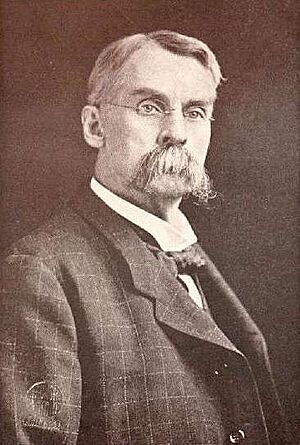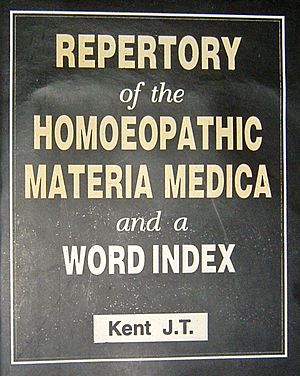James Tyler Kent facts for kids
James Tyler Kent (1849–1916) was an American doctor. He is best known as an important figure in the history of modern homeopathy. In 1897, Kent published a huge guide called Repertory of the Homeopathic Materia Medica. This book listed many human health problems and the special homeopathic remedies linked to them. It has been translated into many languages and is still used by some homeopathy practitioners today.
Contents
Life and Career
Early Years
James Tyler Kent was born on March 31, 1849, in Woodhull, New York. His parents were Steven and Caroline Kent. He grew up in a very religious family, following the Baptist faith.
Kent went to high school at Franklin Academy in Prattsburgh, New York. After that, he went to Madison University, which is now called Colgate University. He earned his first degree there in 1868 and a master's degree in 1870.
He then studied at the Institute of Eclectic Medicine in Cincinnati, Ohio. There, he learned about regular medicine, but also about naturopathy, homeopathy, and chiropractic. He finished his studies in 1873.
Medical Career
In 1874, Kent got married and moved to St. Louis, Missouri, where he started his medical practice. Sadly, his first wife died shortly after they were married. He became a respected doctor and a member of the Eclectic National Medical Association. Two years later, he became a professor of anatomy at American College in St. Louis.
In 1878, Kent's second wife, Lucy, became very sick. Even though many doctors tried to help her, she didn't get better and was stuck in bed for months. At his wife's request, a homeopathic doctor named Dr. Richard Phelan was called. After Dr. Phelan gave her a homeopathic remedy, Lucy got much better very quickly. Because of this, Kent decided to study with Dr. Phelan and changed his focus from eclectic medicine to homeopathy.
Homeopathy is a type of alternative medicine. It claims to treat people by giving them very tiny amounts of substances. These substances, if given to a healthy person, would supposedly cause symptoms similar to the illness. Homeopaths believe that these tiny amounts help the body heal itself.
In 1881, Kent became a professor of anatomy at the Homeopathic College of Missouri. He worked there until 1888. During this time, his second wife also passed away.
In 1890, Kent moved to Pennsylvania. He became the Dean of Professors at the Post-Graduate Homeopathic Medical School of Philadelphia, staying there until 1899.
Later, Clara Louis Tobey, who was also a doctor and then became a homeopath, was treated by Dr. Kent. She later became his wife and helped him finish his famous books.
In 1897, Kent published his most important work, Repertory of the Homœopathic Materia Medica. This book is a guide to illnesses and their related homeopathic "similars." It is still a very important book for how homeopathy is practiced today.
Kent also edited a journal called Journal of Homeopathics from 1897 to 1903.
In 1903, Kent moved to Chicago and taught at Hahnemann Medical College. In 1909, he became a professor and Dean at Hering Medical College and Hospital, also in Chicago.
In 1910, Kent helped start the Society of Homeopathicians. This group aimed to share the ideas of homeopathy. They also published their own journal, The Homeopathician.
Kent wrote many books, and his works were translated into several languages during his lifetime. He became very popular in India, where many of his books are still published today.
His Ideas
James Tyler Kent had some interesting ideas about health and illness. For example, he did not believe in the germ theory, which says that tiny germs cause diseases. He thought that germs were not the real cause of illness.
He also believed that illnesses had spiritual causes. He was a follower of a religious group led by Emanuel Swedenborg. Kent thought that medicine and spiritual beliefs were connected. He also believed in a "vital force," which is an idea that a special life energy exists in living things.
Death and Legacy
Kent passed away on June 5, 1916, in Stevensville, Montana, at the age of 67. He died from a kidney disease called Bright's disease.
After he died, one person who knew him described him as a "kind, gentle, and dedicated friend" to his patients and students. They also said he was a strong protector of pure Homeopathy.
Francis Treuherz, a British expert on homeopathy, called James Tyler Kent "the ultimate homeopath" from a time when homeopathy was very popular in America. Treuherz noted that Kent was known for using very high dilutions in his remedies and for his careful work in creating his important repertory book.
Works
- Repertory of the Homœopathic Materia Medica. Lancaster, PA: Examiner Printing House, 1897.
- Lectures on Homoeopathic Materia Medica. Philadelphia: Boericke & Tafel, 1905.
Images for kids
See also
 In Spanish: James Tyler Kent para niños
In Spanish: James Tyler Kent para niños




